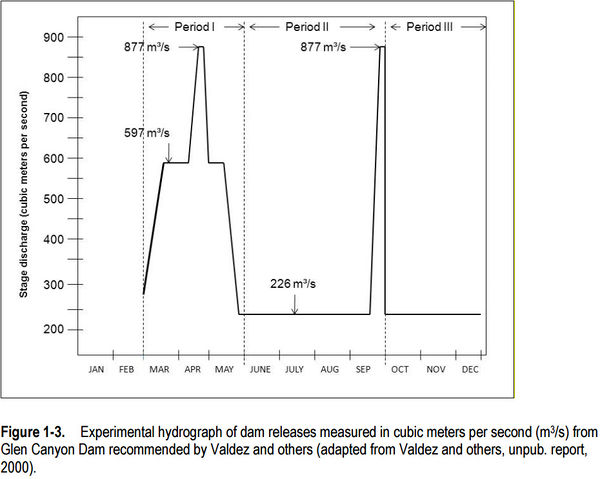Difference between revisions of "Low Summer Flow Experiment"
Cellsworth (Talk | contribs) |
Cellsworth (Talk | contribs) |
||
| Line 97: | Line 97: | ||
*Increased bioenergetic demands of humpback chub via warmer water while decreasing food supply and availability. | *Increased bioenergetic demands of humpback chub via warmer water while decreasing food supply and availability. | ||
*Increased sediment transport during the high releases in the months prior to the LFS test in order to get the annual volume commitment to the Lower Basin. | *Increased sediment transport during the high releases in the months prior to the LFS test in order to get the annual volume commitment to the Lower Basin. | ||
| − | *Increased | + | *Increased potential for nonnative fish and parasites to proliferate throughout the Grand Canyon and impact humpback chub and other native fish populations. |
| − | *The cost to hydropower users from the 2000 | + | *The cost to hydropower users from [http://gcdamp.com/index.php?title=The_2000_Low_Summer_Steady_Flow_Experiment '''the 2000 Low Summer Steady Flow Experiment'''] was estimated to be $26.4 M, which probably made it the single most expensive science experiment in US history. |
|- | |- | ||
| Line 105: | Line 105: | ||
|style="color:#000;"| | |style="color:#000;"| | ||
| − | * | + | *It may be difficult to model release temperatures far enough in advance to start making releases in order to meet annual release requirements. |
| − | * | + | *It may be difficult to schedule mid-year monthly releases in order to meet annual release requirements. Monthly volumes of October-December are typically pre-determined to release 2.0 MAF. Annual release volumes are typically only set after the April 1 inflow forecasts leaving April, May, and June as the only months water could be moved into from July, August, and September for the LSF. |
| − | *Short notice for science planning to monitor affects. One of the primary flaws with the 2000 | + | *Short notice for science planning to monitor affects. One of the primary flaws with [http://gcdamp.com/index.php?title=The_2000_Low_Summer_Steady_Flow_Experiment '''the 2000 Low Summer Steady Flow Experiment'''] was that due to the short amount of time available for planning and implementation and the lack of long-term monitoring, scientists were unable to determine whether or not the experiment achieved its objectives. |
|} | |} | ||
| Line 122: | Line 122: | ||
*[http://gcdamp.com/index.php?title=The_2000_Low_Summer_Steady_Flow_Experiment The 2000 Low Summer Steady Flow Experiment] | *[http://gcdamp.com/index.php?title=The_2000_Low_Summer_Steady_Flow_Experiment The 2000 Low Summer Steady Flow Experiment] | ||
| + | *[http://gcdamp.com/index.php?title=TEMPERATURE Temperature Page] | ||
| + | *[http://gcdamp.com/index.php?title=Humpback_Chub_Page Humpback Chub Page] | ||
|- | |- | ||
| Line 128: | Line 130: | ||
|style="color:#000;"| | |style="color:#000;"| | ||
| − | *[https://pubs.er.usgs.gov/publication/ofr20111220 '''Summary report of responses of key resources to the 2000 Low Steady Summer Flow experiment, along the Colorado River downstream from Glen Canyon Dam, Arizona''' | + | *[https://pubs.er.usgs.gov/publication/ofr20111220 '''Summary report of responses of key resources to the 2000 Low Steady Summer Flow experiment, along the Colorado River downstream from Glen Canyon Dam, Arizona''', 2011 USGS-GCMRC Open-File Report] |
*[https://pubs.usgs.gov/of/2013/1066/of2013-1066_text.pdf Water temperatures in select nearshore environments of the Colorado River in Grand Canyon, Arizona, during the Low Steady Summer Flow experiment of 2000] | *[https://pubs.usgs.gov/of/2013/1066/of2013-1066_text.pdf Water temperatures in select nearshore environments of the Colorado River in Grand Canyon, Arizona, during the Low Steady Summer Flow experiment of 2000] | ||
Revision as of 15:35, 3 May 2017
|
|
LTEMP Experimental Action: Aquatic Resource-Related Experimental Treatments (BA, pages 30-41) [1]Low summer flows may be tested in the second 10 years of the LTEMP period, for the purpose of achieving warmer river temperatures (≥14°C) to benefit humpback chub and other native species. Under low summer flows, daily fluctuations would be less than under base operations (e.g., approximately 2,000 cfs). Investigating the anticipated effects of and options for providing warmer water temperatures in the mainstem Colorado River through Grand Canyon is an identified management action in the Humpback Chub Recovery Goals (USFWS 2002a). |
| --- |
--- |
--- |
|---|
|
|
